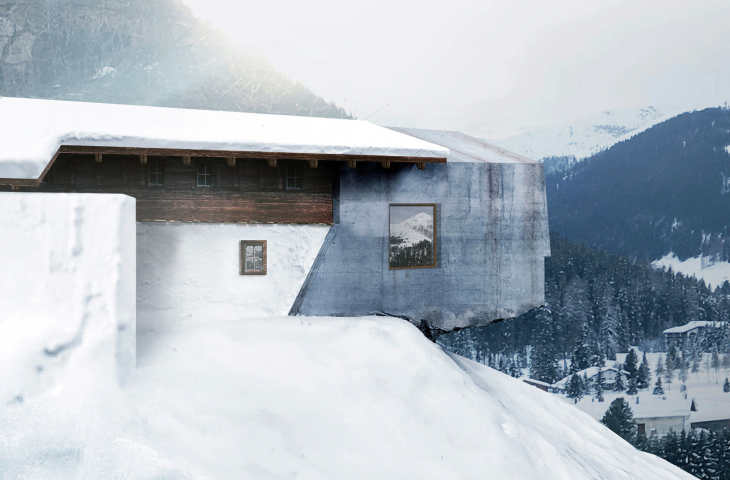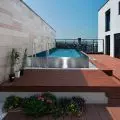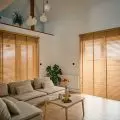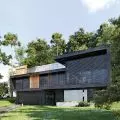interview from issue 03|2021 of A&B
A unique house designed by a local office Architecture Club, run by architects from Poland, is under construction in the Swiss Alps. An old wooden hut located on a hill will be wrapped in a modern, brutalist exterior. Warm wood will wrap the cold concrete, which will be like a frame. Literally, because the wooden facade will be in the interior.
Although in terms of dimensions it is not a big project, it can be taken symbolically, spinning a reflection on the trends of modern architecture and its relation to the past. The architects decided that a modern material that doesn't pretend to be anything would be the best choice for this site - for the structure and shape of the building, but also its aesthetics. The owners of the house collect art, so artistic references seem most justified here. The decorative wooden wall becomes a work of art in the interior of the house. Surrounded by concrete, it is perfectly exposed. On the other concrete walls are to hang paintings. On the opposite side will be a large window - the antithesis of the small windows in the wooden facade, which is like another work of art. This work of art is a concrete-framed view of the mountain landscape and a town looming in the valley.
It can be said that the project - named Denkraum - is a sign of the times. Traditional wooden construction, with which the Alps are associated, is visually giving way to a new aesthetic and at the same time coming under protection. Its undisputed value is being surrounded by reverence. And what value do contemporary building techniques and materials bring? This is the context of the conversation with architects. Sustainable construction is very important to them, but, they say, the use of wood is not always justified.
conceptual model showing the structural idea - the cantilever of the new volume is made possible by embracing the existing house in the underground section
© Architecture Club
With Karolina Slawecka and Pawel Krzeminski of Architecture
Club is interviewed by Katarzyna Jagodzinska
Katarzyna Jagodzinska: The project you are currently working on is a combination of the historic wooden body of the house and a contemporary concrete structure, which is an extension of the house and at the same time its packaging. What did your task consist of?
Pawel Krzeminski: The owners of an old wooden châlet in the Swiss mountains wanted to extend the existing house. They needed more space, breath, and an open view.
Karolina Slawecka: Traditional mountain houses are characterized by having small openings, designed inward, introverted. The rooms are relatively small and low. At the same time, this house is beautifully located: on the side of a mountain with a fantastic panoramic view of the alpine peaks, with a town at its foot. So it was natural to want to "invite" this view inside.
Working models - studies of openings in a new volume; in the process, a scaled-down square window
evolved into a panoramic opening, the protruding roof was reduced
© Architecture Club
Paul: The house is also unusual in cross-section. You enter on the top floor, where the bedrooms are, and the living room is a floor below. It descends parallel to the slope. The current living room is low, and small windows frame parts of the view.
Karolina: The investors were looking to expand, but they didn't specify either the size or how to enlarge the space.
Paul: Actually, it was clear to us right away that what they needed was a large space. As in Monika Sosnowska's Atelier project, we covered a lot of emptiness with volume [cf. A&B 04/2020].
Karolina: The clients called this as yet undesigned space a workshop. They didn't want it to be a living room per se, where you sit on a couch by the fireplace, with a view. They preferred to have a large table there to work on, where they could also display books and other objects. Since they collect art, they wanted to be able to display and contemplate it. We eventually named this project Denkraum, or "thinking room."
Paul: The existing old wooden house was, of course, the starting point. The new space is its geometric extension in reinforced concrete construction. With this move, we made the exterior wall of the old châlet now part of the interior.
working models - opening studies in the new volume; in the process, the scaled square window evolved into a panoramic opening, the protruding roof was reduced
evolved into a panoramic opening, the protruding roof was reduced
© Architecture Club
Catherine: From the old house only this wall will remain, will the whole structure of the house stay and be part of the new whole? Are you demolishing anything?
Karolina: Since this wall is a beautiful example of a distinctive Alpine facade, the new building will embrace and protect it. We really liked the fact that suddenly this facade will become the interior wall of the new volume. The only demolition is to undercut this facade along its entire length at ground zero and support it with a concrete and steel beam and a diagonal new wall, the so-called art wall.
Paul: This undercut connects the old part with the new part in the lower level, which, by the way, was not originally wooden at this point, but plastered.
Catherine: And what does it look like from a surface perspective: what was the surface area of the house before and what are you aiming for?
Paul: When we started the process, square meters were not specified. We presented three proposals to the investors, including two with a much smaller volume, but in the end the most radical one prevailed.
Karolina: It was also the first intuitive solution. Later, we proposed two more completely different concepts to see if this was indeed the most appropriate idea.
Paul: Originally the living room was roughly sixty square meters, and we added more than eighty to it. However, the most important thing was the height. From a room that is 2.4 meters high, we enter a two-story space that is locally as high as seven meters.
Karolina: It was crucial to find the right proportion between the existing living room and its new part.
A view of the wooden facade that became the inner wall of the Denkraum; a radical undercut in the first floor,
supported by a concrete beam, allows a seamless connection between the new and old parts of the house
© Architecture Club
Catherine: That is, a new house is actually being built, not just a new wing. This is a radical remodeling. You probably won't be able to live there during the construction work.
Paul: Definitely not. This is, as you say, a radical remodeling.
Karolina: This project is a battle against gravity, or rather an attempt to find the perfect balance of natural forces. The extension structurally includes a stone basement, and the above-ground part levitates above the slope. It's a physical counterweight so that, without weighing down the wooden structure, we achieve the maximum overhang. At the same time, the old house is protected, because the biggest intervention takes place underground, in the masonry part.
Paul: The client's dream was to open the window, sit on the edge of the jib and swing his legs. The mass of the old basement allowed us to extend the new volume above the slope without the need to support it. We want to pour the exposed concrete overhang directly on the soil coming from the excavation. Its texture will thus be very organic, just like the rock on which the house sits.

















































